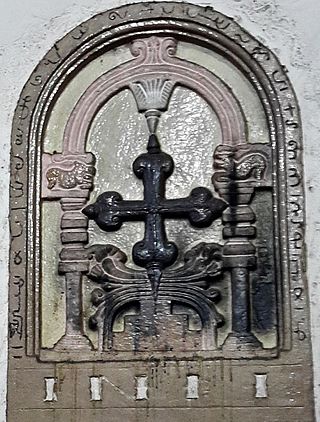
The Catholic Church in Nigeria is part of the worldwide Catholic Church, under the spiritual leadership of the Pope, the curia in Rome, and the Catholic Bishops' Conference of Nigeria (CBCN).

The Portuguese Catholic Church, or Catholic Church in Portugal, is part of the worldwide Catholic Church in communion with the Pope in Rome, under the Portuguese Episcopal Conference. The Catholic Church is the world's largest Christian organisation. It is Portugal's largest religion and its former state religion, and has existed in the territory since the Iberian Peninsula was ruled by the Roman Empire.

The Diocese of Stockton is a Latin Church ecclesiastical territory, or diocese, of the Catholic Church in the Central Valley and Mother Lode region of California in the United States. It is a suffragan diocese in the ecclesiastical province of the metropolitan Archbishop of San Francisco

The Bombay East Indians, also called East Indian Catholics or simply East Indians, are an ethno-religious Indian Christian community native to the Seven Islands of Bombay and the neighbouring Mumbai Metropolitan Area of the Konkan division, along the western coast of India.

Sandor is a census town falling within the Vasai (Bassein) municipality of the Palghar district, in the Konkan division of Maharashtra, India. Sandoris, the natives of Sandor, are predominantly Roman Catholic Kshatriyas of the Christian Bombay East Indian community, they converted in the colony centred around Bassein, the richest possession of the former Portuguese East Indies with the capital at Velha Goa, in the southern edge of the Konkan region. Prior to the arrival of Portuguese Armadas, there had also been some Nestorians descended from Jewish converts, by the efforts of the apostles Thomas or Bartholomew.

Joseph Vaz, CO was an Oratorian priest and missionary in Sri Lanka (Ceylon). Originally from Sancoale in Portuguese India, Vaz arrived in Ceylon during the Dutch occupation, a time when the Dutch had banned Catholicism in Ceylon and imposed Calvinism as the official religion after taking control from the Portuguese Empire.

The Diocese of Quilon is a Latin Church ecclesiastical jurisdiction or diocese of the Catholic Church based in the southern Indian city of Kollam. It is a suffragan in the ecclesiastical province of the metropolitan Archdiocese of Trivandrum. The Diocese of Quilon covers an area of 1,950 km2 that contains a population of some 4.8 million. At least 4.8% of the people in the area are Catholic.

The Catholic Church in India is part of the worldwide Catholic Church under the leadership of the Pope. There are over 20 million Catholics in India, representing around 1.55% of the total population, and the Catholic Church is the single largest Christian church in India. There are 10,701 parishes that make up 174 dioceses and eparchies, which are organised into 29 ecclesiastical provinces. Of these, 132 dioceses are of the Latin Church, 31 of the Syro-Malabar Catholic Church and 11 of the Syro-Malankara Catholic Church. Despite the very small population that Indian Catholics make up percentage wise, India still has the second-largest Christian population in Asia after the Catholic Church in the Philippines.

San Thome Church, officially known as St Thomas Cathedral Basilica and National Shrine of Saint Thomas, is a minor basilica of the Catholic Church in India, at the Santhome neighbourhood of Chennai, in Tamil Nadu. The present structure dates back to 1523 AD, when it was built by the Portuguese over the tomb of Thomas the Apostle. In 1896, it was renovated in the Madras province according to neo-Gothic designs, as was favoured by British architects in the late 19th century.

The Diocese of Jaffna is a Latin Church ecclesiastical territory or diocese of the Catholic Church in northern Sri Lanka. Latin Catholicism in the diocese's territory dates to the time of Francis Xavier. The current bishop is Justin Gnanapragasam.

The Syro-Malabar Catholic Eparchy of Kalyan is an Eastern Catholic eparchy in India within the Syro-Malabar Catholic Church, based in Kalyan, India. The eparchy was established to cater the spiritual needs of the Syro Malabar Christians based in the Indian State of Maharashtra including the metropolitan cities of Mumbai, Pune and Nasik. Its first bishop was Mar Paul Chittilapilly. The current bishop is Mar Thomas Elavanal. The Eparchy celebrated its silver jubilee in the year 2013.

The Roman Catholic Archdiocese of Bombay is a particular church celebrating the Latin Rite of worship, centred in the Bombay (Mumbai) city of the northern Konkan division of Maharashtra, India. The archdiocese has been a Metropolitan see since its elevation, by Pope Leo XIII on 1 September 1886.

The Roman Catholic Diocese of Poona is a diocese located in the city of Pune in the ecclesiastical province of Archdiocese of Mumbai in India.

The Roman Catholic Diocese of Cochin is a Roman Catholic Diocese in Kochi, Kerala, India. A constituent of the sui iuris Latin Church, the diocese was established in 1557 after the domination of the Portuguese-speaking missionaries. The diocese is a suffragan church to the ecclesiastical province of the Metropolitan Latin Catholic Archdiocese of Verapoly, and serves the Latin Catholics of Malabar.

The Roman Catholic Metropolitan Archdiocese of Goa and Daman encompasses the Goa state and the Damaon territory in the Konkan region, by the west coast of India. The ecclesiastical province of Goa and Damaon includes a suffragan diocese, the Sindhudurg Diocese that comprises the Malvani areas of. The Archbishop of Goa also holds the titles of Primate of the East and Patriarch of the East Indies, also hold the title of the Syrian Catholic Primate of the Archdiocese of Cranganore. The beginnings lie in the Padroado system of Portuguese Goa and Damaon, in the early 1900s the primatial see was transferred back to the Sacred Congregation for the Evangelisation of Peoples, as the Padroado system of the Indo-Portuguese era was being dismantled.

The Conference of Catholic Bishops of India (CCBI) is the national episcopal conference of the bishops of the Latin Church of the Catholic Church in India, functioning in accordance with canon 447. There are 132 Latin Catholic dioceses in the country, and 190 active and retired bishops are the members of the CCBI. This is the largest bishops' conference in Asia and the fourth-largest in the world. The CCBI is a member of the Federation of Asian Bishops' Conferences.

The Saint Thomas Christian denominations are Christian denominations from Kerala, India, which traditionally trace their ultimate origins to the evangelistic activity of Thomas the Apostle in the 1st century. They are also known as "Nasranis" as well. The Syriac term "Nasrani" is still used by St. Thomas Christians in Kerala. It is part of the Eastern Christianity institution.

Francis Pereira S.J. is an Indian Jesuit priest, scripture scholar and Marathi writer. He is professor Emeritus of Jnana Deepa, Institute of Philosophy and Theology, Pune, India. He has contributed to the study of the Bible and especially through his Biblical commentaries in Marathi, the language of Maharashtra, India.
Holy Spirit Church, Nandakhal is a historic Roman Catholic Church in Vasai (Bassein), Maharashtra, India. This church was built in 1573 by Portuguese Missionaries.
Felix Anthony Machado is an Indian prelate of the Catholic Church who was Archbishop of Vasai since 2009 to 2024. He spent a decade in the Roman Curia as under-secretary of the Pontifical Council for Interreligious Dialogue.

















